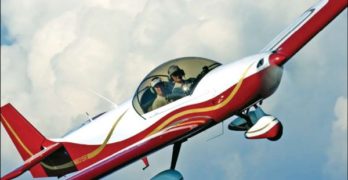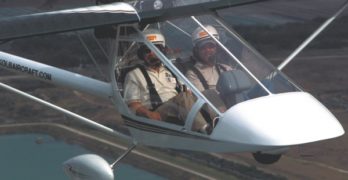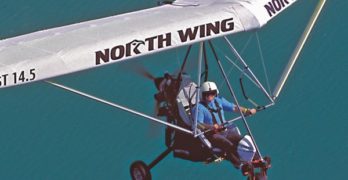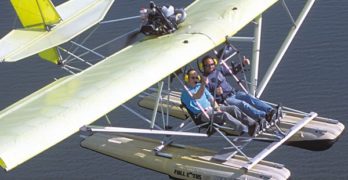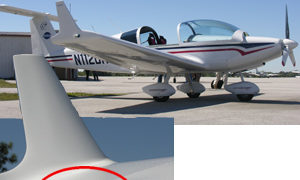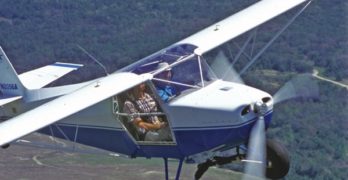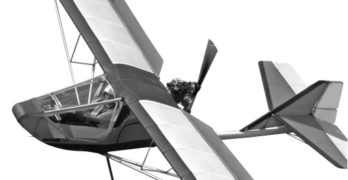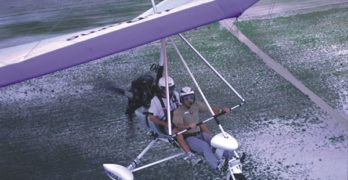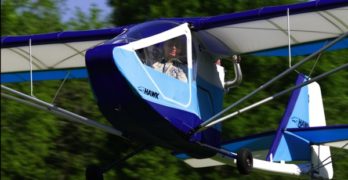The strongest interest in readyto-
fly special light-sport aircraft
(S-LSA) to date has come
from pilots operating Cessna, Piper,
Mooney, and other general aviation
(GA) aircraft. It is estimated that more
than 100,000 currently certificated pilots
are looking at their prospects for
maintaining an up-to-date second- or
third-class FAA medical and considering
the LSA option. Many are concluding
that LSA are worthy airplanes
and recognize that downsizing to an
LSA two-seater can meet their flying
goals, a fact that has driven a good
share of LSA sales thus far.
Thousands of those pilots have private
or higher certificates with instrument
ratings. They’re accustomed to
having a full panel and want one even
if flying in instrument meteorological
conditions (IMC) isn’t in their plans. In
fact, flashy dual-screen plus electronic
information and navigation panel
layouts have proven quite popular in
many S-LSA, even though they add tens
of thousands of dollars in cost.
Search Results for : Flight Design
Not finding exactly what you expected? Try our advanced search option.
Select a manufacturer to go straight to all our content about that manufacturer.
Select an aircraft model to go straight to all our content about that model.
Refined Kolb Mark III Xtra
“Xtra” - a word to make a computer spell-checker stumble – is an appropriate name for this month’s pilot’s report, The New Kolb Aircraft Company Mark III Xtra side-by-side 2-seater. It literally offers extra in several ways pilots will like.
The venerable Mark III has been through a series of changes since original company founder Homer Kolb first brought out a 2-seater called the TwinStar. The latest change does a lot to alter the appearance of the older design.
Kolb designs have narrow noses like a lot of other designs. The new Xtra presents a clean edge cutting through the air, but it now has a wider look – at least from head-on – that imparts a new feel to the occupants. Some will say the “Xtra” comes from “Extra-Wide.” With its bulging doors, the new cabin is 45 inches wide (42.5 at the hips).
Although the design will look bigger and heavier to some, the new shape is one you’ll come to like… if you have a seat.
Co-Developing the Navajo Trike
A couple of years ago, TC’s Trikes owner TC Blyth and North Wing owner Kamron Blevins joined forces in a cooperative arrangement. TC’s Trikes would buy wings from North Wing (rather than continue to make their own), and could better represent North Wing on the Eastern Seaboard. North Wing, headquartered in the northwestern state of Washington, is far from TC’s Trikes’ Tennessee home. It seemed a marriage of convenience and more.
Blyth has been particularly active in training and introductory flight lessons. He’s done many thousands of them at his location near a top Tennessee tourist and outdoorsmen attraction – the Ocoee River, popular for white water rafting, kayaking, and other sports. Blyth has been focused on meeting this need with his own brand of trikes, and all his experience gave him something clear and viable to add to the expertise of North Wing.
North Wing has risen to the top of the U.S.
Float-Flying the M-Squared Sprint 1000
“Air in your hair!
Space on your face! A breeze on your knees!” A former colleague of mine used to repeat this short mantra to illustrate the joy of open-cockpit flying. It was catchy and engaging and his customers liked it.
With 15 Light-Sport Aircraft now possessing their FAA Special Light-Sport Aircraft (SLSA) airworthiness certificates, not a single one is open cockpit, though the IndUS Thorpedo, Legend Cub, and Tecnam Sierra can enjoy partially open cockpits.
Special Light-Sport Aircraft will eventually add more of this genre of light aircraft but one of the beauties of FAA’s new regulation is that it does not eliminate two previous categories: Amateur-built 51% kits or Part 103-compliant ultralights.
With 21¼4 years left before operators of 2-seat 496-pound empty weight ultralight exempt trainers must register in FAA’s new Light-Sport Aircraft category, and with 41¼4 years left while these machines can be used for compensated training flights, the segment still has lots of life remaining.
Skylark, a “Clean Sheet” Light-Sport Aircraft
When you walk up to Skylark, you get an impression that usually lasts (a marketer’s dream come true). While uncommon in light sport aviation winglets are well established on fast airplanes from bizjets to airliners. As a design feature, winglets that stick in your mind make the wingtip device a winner for sales reasons; any aerodynamic gain is icing on the cake. *** Burt Rutan is credited with first using the idea on his VariEze in 1975 and it was subsequently used by the Learjet 28 and the McDonnell Douglas MD-11. But the concept was invented even before the Wright Brothers first flight, way back in 1897. Even then they knew about wingtip vortices. Get more winglet info. Skylark has become Sportsplanes.com‘s top-of-the-line LSA, flanked by the Breezer, C42, and American Flyer. Skylark was designed by Canadian David Marsden, who engaged Dova of Czech Republic to built it, later selling them the design rights.
Just Aircraft’s Highlander
If you’re familiar with Avid Flyer or Kitfox aircraft, you know at least something about Just Aircraft’s Highlander. Its pedigree “path” is somewhat meandering but leads to an excellent flying machine born of a rich American airplane design heritage.
Dean Wilson was the originator of this now-proven design shape. The first departure from Wilson’s Avid Aircraft company was Dan Denney, who went on to offer the Kitfox. Denney’s prowess as a marketer brought international fame to the Kitfox and, over the years, the sale of nearly 3,000 aircraft. At one time Denney Aerocraft was among the country’s largest suppliers of kit-built aircraft. What had been an ultralight design evolved into a successful 2-seat homebuilt, but that wasn’t the end of the evolution behind Wilson’s original creation. Denney sold his company to Phil Reid, who renamed the Idaho company SkyStar.
A Well-Evolved History
Another break-off from Avid Aircraft and Denney Aerocraft was Flying K Enterprises, which introduced the single-seat Sky Raider.
CGS Aviation Makes Hawk
Remember why we fly ultralights? Few general aviation airplanes are flown below 1,500 feet above the ground. More rare is flight at 500 feet or 50 feet. Neither do you tend to fly most light-sport aircraft (LSAs) at these denser altitudes. Most flights in general aviation or LSA planes start out climbing high as quickly as possible. You switch on the autopilot as soon as possible and fiddle with the throttle, prop and mixture controls to squeeze all the fuel economy you can while flying as fast as the machine will manage in the straightest possible line all the way to your destination.
That’s fine for general aviation or LSA flying, and it’s enjoyable in a different way. But it isn’t ultralight flying.
What about just “boating around” the sky at your leisure, turning every few minutes to see the sights only possible from an ultralight aircraft. Your eye catches an alligator off to one side and you bank quickly to check it out.
NH:Friends of Dan
If you want a forum for Sport Pilot and Light-Sport Aircraft, you need look no further than SportPilotTalk.com.
This comprehensive and professionally designed website will let you sound off on a variety of topics. You can
also find many links to other valuable resources.
Adventure Productions has a complete line of DVD and printed book products to
help you learn about Sport Pilot/Light-Sport Aircraft. Clicking their link above
leads you to their pilot store where you can order direct from them. Your
purchases via my Adventure Productions affiliation will help support
ByDanJohnson.com.
Sharing the cost of a new LSA makes a lot of sense. LetsFly.org is committed to
helping you do this. Through my ByDanJohnson.com affilation with LetsFly.org, you
can also order flight accessories. Your purchases via my LetsFly web presence will
help support ByDanJohnson.com.
AirBorne’s Edge X Wizard Trike
For years now, the boys from “down under” at AirBorne Australia, led by co-owner Russell Duncan, have been coming to America. The ultralight they have been showing is the deluxe Edge Executive model. It’s a beauty, but the company lacked a simpler, lower-cost model. No more!
In April of last year, Duncan and crew debuted what they call the Edge X Wizard model. The “Edge X” series refers to the new trike carriage, above which you can have the double-surface Edge wing, making the Executive trike, or you can select the new single-surface Wizard wing. It is this new offering that is the focus of this pilot’s report.
Smoothly finished in all-white powder coating, and lacking the nose pod and aft fairing, the new Edge X trike carriage looks light and basic. At only $11,700 fully assembled, it should find a market in the USA, I feel. (The figure is complete in every way except for an import shipping charge, which U.S.
CGS Pulls Out the Stops
… to keep the Hawk Ultra Light
Genuine ultralights still
have a place. These
aircraft|excuse me,
ultralight vehicles,
the least-FAA-regulated
flying machines,
will not be sent to aircraft boneyards
despite what some light-sport aircraft
skeptics may think. The Hawk Ultra
is proof positive CGS Aviation loves
ultralights and wants you to have fun
in the air.
No matter the pros and cons of
the sport pilot/light-sport aircraft (SP/
LSA) rule, operating a Part 103 ultralight
remains simpler than earning a
sport pilot certificate and buying an
LSA. No certificate, no medical, and
no registration is needed (though, it is
recommended that folks register with
one of the three associations supporting
ultralights-EAA, the United States
Ultralight Association (USUA), and Aero
Sports Connection (ASC). Additionally,
an ultralight can be fully factory built
without FAA inspections. The list of 103
privileges goes on, and the Hawk Ultra
qualifies for all of them.
One-Oh-Three Interest Soars
I don’t know about the “build it
and they will come” premise when
it comes to baseball fields, but I fervently
believe that if enough customers
want a product, someone will supply
it.
- « Previous Page
- 1
- …
- 115
- 116
- 117
- 118
- 119
- …
- 147
- Next Page »


